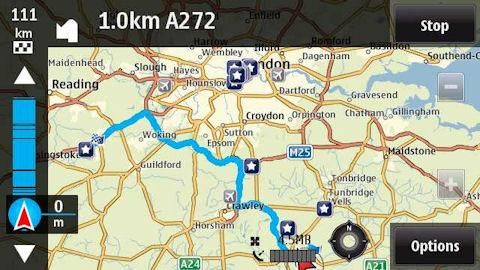The largest phone maker in the world has announced Thursday that it has made available its Ovi Maps—Nokia's turn-by-turn GPS navigation solution—free for the company's smartphones. In a bid to try and capture some of the US market—which has thus far been dominated by RIM and newcomer Apple—Nokia's move can be seen as competitive with Google, which has offered free turn-by-turn GPS navigation on Google Maps with Navigation on select Android devices for the US market. Nokia is responding by saying its Ovi Maps service will be in over seventy countries and nearly fifty different languages compared to Google limiting turn-by-turn to just the US market with one choice of voice selection.
By offering free navigation on its handsets, Nokia hopes to double the number of users (currently at 27 million) who use GPS on their phones.
Leveraging its Business Since its acquisition of mobile mapping firm Navteq (a competitor to TeleAtlas), Nokia is using its premium mapping feature to leverage the value proposition offered by its smartphones, especially in the US market where its high end smartphones haven't gained much market share. GPS apps can range anywhere from around $20 to over $100 for turn by turn guidance will now be seen as a premium that boosts the asking price of the phone. With Nokia bundling this service, even the unsubsidize $500 asking price of its smartphone will even seem more reasonable. For comparison, an iPhone 3GS (32 GB model) can retail without a contract for around $700 and if you throw in the excellent Navigon GPS app that will add another $90. An N97 Mini, sold unlocked and without a need for a contract, retails for $550 and comes with mapping service for free.
Also of note, competitor Garmin, a GPS maker, is tackling maps as well by entering the GPS and smartphone business. The company, through its partnership with Asus, has begun to build navigation devices with smartphone features—you can read about the latest Garmin-Asus news here.
Value Proposition Not only is Nokia offering GPS maps, it is also adding its expertise with points of interests (POI) for the driver and for the pedestrian. Also included with the package are city travel guides from Lonely Planet—which is a nice way to explore a city and find something to do in a new town—I've tried the Lonely Planet guide for San Francisco and was able to acquaint myself with some parks, museums, neighborhoods, architectural landmarks, restaurants, and cafes of interests. In pedestrian mode, the casual walker can also use Nokia's extensive mapping expertise to find restrooms, escalators and elevators, and other useful pedestrian-related mapping features, which is a nice touch compared to conventional GPS solutions as Nokia has truly thought about the needs of pedestrians exploring a new area.
Even better is the fact that you can download maps natively to your device, which is a different strategy than Google Maps with Navigation on Android or with TeleNav (also available under Sprint and AT&T branding in the US)—the latter two requires a constant data connection to download maps and directions OTA. With pre-loaded map content, you can conserve battery power by not needing a constant wireless radio in addition to the GPS radio being on while navigating. Additionally, if you are exploring an area with weak or no wireless coverage, your maps will still work. Nice touch, Nokia!
Value for Carriers Nokia is also saying that its mapping service will be good for carriers as well since the map downloads will consume less bandwidth on mobile devices, though we've yet to see how this will affect carriers who already have their own mapping service like Verizon Wireless with VZ Navigator, AT&T Navigator, or Spring Nav. According to CNET, "Ojanperä said that the technology Nokia uses to serve up its maps is 10 times more network efficient than Google's method. Nokia uses what's called a hybrid vectorizing mapping method, which allows users to zoom in and out of the map without downloading the same map multiple times. By contrast, Ojanperä said that Google's technology requires that a new map be downloaded each time a user zooms in or out of the map, which increases the amount of bandwidth needed to use the service."
A Package Deal With all the different add-on services, Nokia seems to have all the pieces to make a great package and it seems that the technologies are now mature enough for the firm to begin offering things together as part of a sweet deal. Nokia Conversations integrate well with SMS and emails; there's a Nokia social app that integrates nicely with Facebook that I got to see at CTIA in October; I've also spent extensive time with Nokia Messaging, an app that brings push email to the masses by integrating your existing Yahoo, GMail, and most other email accounts and pushes mail to your device; the firm already offers a free email service through Ovi Mail; and with mapping, Nokia is now packaging maps and navigation as part of its high-end smartphone.
Whether that strategy is successful for the company in gaining market share in the US remains unknown, but Nokia is definitely making the consumer a winner here. Nokia has all many of the different cloud-based services through its Ovi portal to compete with Google, and its Symbian^4 user interface—slated for 2011—looks fresh and sleek enough to compete against the likes of webOS, iPhone, and Android. We'll definitely be keeping an eye on Nokia to see how the company can use its different businesses to add value to its smartphones and not become a mere commodity in a rapidly changing industry.
To download Ovi Maps for your Nokia Symbian phone, please visit the download page.
(via: CNET)

